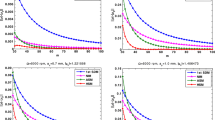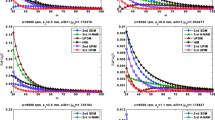Abstract
Chatter stability prediction is an important technique for obtaining chatter-free cutting parameters to enhance product quality and achieve better cutting performance. Based on the exponential fitting multistep algorithms and Fibonacci search, this paper presents an implicit exponentially fitted method to efficiently and accurately determine the chatter stability limits. The dynamic model with consideration of the regeneration effect for milling processes can be expressed as delay-differential equations (DDEs) with time-periodic coefficients. The tooth-passing period can be subdivided into two distinct phases according to whether the cutting tool is contacting the machined parts. On the basis that the forced vibration phase can be discretized into time intervals of identical duration, a three-step implicit exponentially fitted method is developed to estimate the state term. Subsequently, the milling stability boundary can be obtained by using the Fibonacci search to substitute traditional sequential search, which can remarkably reduce the computational time. The effectiveness of the implicit exponentially fitted method is validated through making comparisons with the other two benchmark methods. Simulation results indicate that the implicit exponentially fitted method exhibits excellent accuracy and efficiency. Furthermore, the experimental verification was performed to further demonstrate the availability and validity of the implicit exponentially fitted method. On this basis, we extend the implicit exponentially fitted method to the variable pitch cutters case. Furthermore, a benchmark example is provided to evaluate the feasibility of the extended implicit exponentially fitted method. The results indicate that the implicit exponentially fitted method can achieve significantly better computational efficiency and accuracy.










Similar content being viewed by others
References
Tao JF, Qin CJ, Xiao DY, Shi HT, Ling X, Li BC, Liu CL (2019) Timely chatter identification for robotic drilling using a local maximum synchrosqueezing-based method. Journal of Intelligent Manufacturing. https://doi.org/10.1007/s10845-019-01509-5
Quintana G, Ciurana J (2011) Chatter in machining processes: a review. Int J Mach Tools Manuf 51(5):363–376
Tao JF, Qin CJ, Xiao DY, Shi HT, Liu CL (2019) A pre-generated matrix-based method for real-time robotic drilling chatter monitoring. Chinese Journal of Aeronautics. https://doi.org/10.1016/j.cja.2019.09.001
Qin CJ, Tao JF, Liu CL (2018) A predictor-corrector-based holistic-discretization method for accurate and efficient milling stability analysis. Int J Adv Manuf Technol 96(5–8):2043–2054
Altintas Y, Budak E (1995) Analytical prediction of stability lobes in milling. CIRP Ann 44(1):357–362
Merdol SD, Altintas Y (2004) Multi frequency solution of chatter stability for low immersion milling. J Manuf Sci Eng 126(3):459–466
Bayly PV, Mann BP, Schmitz TL, Peters DA, Stepan G, Insperger T (2002) Effects of radial immersion and cutting direction on chatter instability in end-milling. In: proceedings of the international mechanical engineers conference and exposition. New Orleans, Paper No.IMECE2002–39116
Yan Z, Liu Z, Wang X, Liu B, Luo Z and Wang D (2016) Stability prediction of thin-walled workpiece made of Al7075 in milling based on shifted Chebyshev polynomials. Int J Adv Manuf Technol 87(1–4):115–124
Insperger T, Stepan G (2004) Updated semi-discretization method for periodic delay-differential equations with discrete delay. Int J Numer Methods Eng 61(1):117–141
Insperger T, Stepan G, Turi J (2008) On the higher-order semi-discretizations for periodic delayed systems. J Sound Vib 313(1–2):334–341
Insperger T (2010) Full-discretization and semi-discretization for milling stability prediction: some comments. Int J Mach Tools Manuf 50(7):658–662
Balachandran B (2001) Nonlinear dynamics of milling processes. Philos Trans R Soc A 359(1781):793–819
Long X, Balachandran B (2007) Stability analysis for milling process. Nonlinear Dyn 49(3):349–359
Wan M, Zhang W, Dang J, Yang Y (2010) A unified stability prediction method for milling process with multiple delays. Int J Mach Tools Manuf 50(1):29–41
Jin G, Qi HJ, Cai YJ, Zhang QC (2016) Stability prediction for milling process with multiple delays using an improved semi-discretization method. Math Methods Appl Sci 39(4):949–958
Jiang SL, Sun YW, Yuan XL, Liu WR (2017) A second-order semi-discretization method for the efficient and accurate stability prediction of milling process. Int J Adv Manuf Technol 92(1–4):583–595
Ding Y, Zhu LM, Zhang XJ, Ding H (2010) A full-discretization method for prediction of milling stability. Int J Mach Tools Manuf 50(5):502–509
Zhang XJ, Xiong CH, Ding Y (2010) Improved full-discretization method for milling chatter stability prediction with multiple delays. Lect Notes Comput Sci 6425:541–552
Ding Y, Zhu LM, Zhang XJ, Ding H (2010) Second-order full-discretization method for milling stability prediction. Int J Mach Tools Manuf 50(10):926–932
Quo Q, Sun YW, Jiang Y (2012) On the accurate calculation of milling stability limits using third-order full-discretization method. Int J Mach Tools Manuf 62:61–66
Guo Q, Sun YW, Jiang Y, Guo DM (2014) Prediction of stability limit for multi-regenerative chatter in high performance milling. Int J Dyn Control 2(1):35–45
Ozoegwu CG, Omenyi SN, Ofochebe SM (2015) Hyper-third order full-discretization methods in milling stability prediction. Int J Mach Tools Manuf 92:1–9
Li MZ, Zhang GJ, Huang Y (2013) Complete discretization scheme for milling stability prediction. Nonlinear Dyn 71(1–2):187–199
Xie QZ (2016) Milling stability prediction using an improved complete discretization method. Int J Adv Manuf Technol 83(5–8):815–821
Li ZQ, Yang ZK, Peng YR, Zhu F, Ming XZ (2016) Prediction of chatter stability for milling process using Runge-Kutta-based complete discretization method. Int J Adv Manuf Technol 86(1–4):943–952
Niu JB, Ding Y, Zhu LM, Ding H (2014) Runge–Kutta methods for a semi-analytical prediction of milling stability. Nonlinear Dyn 76(1):289–304
Dai Y, Li H, Xing X, Hao B (2018) Prediction of chatter stability for milling process using precise integration method. Precis Eng 52:152–157
Dai Y, Li H, Hao B (2018) An improved full-discretization method for chatter stability prediction. Int J Adv Manuf Technol 96(9–12):3503–3510
Li H, Dai Y, Fan Z (2019) Improved precise integration method for chatter stability prediction of two-DOF milling system. Int J Adv Manuf Technol 101(5–8):1235–1246
Ding Y, Zhu LM, Zhang XJ, Ding H (2011) Numerical integration method for prediction of milling stability. J Manuf Sci Eng 133(3):031005
Ding Y, Niu JB, Zhu LM, Ding H (2015) Numerical integration method for stability analysis of milling with variable spindle speeds. ASME J Vib Acoust 138(1)
Zhang XJ, Xiong CH, Ding Y, Xiong YL (2011) Variable-step integration method for milling chatter stability prediction with multiple delays. Sci China 54:3137–3154
Liang XG, Yao ZQ, Luo L, Hu J (2013) An improved numerical integration method for predicting milling stability with varying time delay. Int J Adv Manuf Technol 68:1967–1976
Ding Y, Zhu LM, Zhang XJ, Ding H (2013) Stability analysis of milling via the differential quadrature method. J Manuf Sci Eng 135(4):044502
Ding Y, Niu JB, Zhu LM, Ding H (2015) Differential quadrature method for stability analysis of dynamic systems with multiple delays: application to simultaneous machining operations. J Vib Acoust 137(2):024501
Zhang Z, Li HG, Meng G, Liu C (2015) A novel approach for the prediction of the milling stability based on the Simpson method. Int J Mach Tools Manuf 99:43–47
Qin CJ, Tao JF, Li L, Liu CL (2017) An Adams-Moulton-based method for stability prediction of milling processes. Int J Adv Manuf Technol 89(9–12):3049–3058
Qin CJ, Tao JF, Liu CL (2017) Stability analysis for milling operations using an Adams-Simpson-based method. Int J Adv Manuf Technol 92(1–4):969–979
Tao JF, Qin CJ, Liu CL (2017) Milling stability prediction with multiple delays via the extended Adams-Moulton-based method. Math Probl Eng 2017:1–15
Tang X, Peng F, Yan R, Gong Y, Li Y, Jiang L (2017) Accurate and efficient prediction of milling stability with updated full discretization method. Int J Adv Manuf Technol 88(9–12):2357–2368
Yan Z, Wang X, Liu Z, Wang D, Jiao L, Ji Y (2017) Third-order updated full-discretization method for milling stability prediction. Int J Adv Manuf Technol 92(5–8):2299–2309
Tang C, Yan HQ, Zhang H, Chen ZQ, Liu M, Zhang GM (2005) The arbitrary order implicit multistep schemes of exponential fitting and their applications. J Comput Appl Math 173(1):155–168
Tang C, Wang WP, Yan HQ, Chen ZQ (2006) High-order predictor corrector of exponential fitting for the N-body problems. J Comput Phys 214(2):505–520
Gradisek J, Kalveram M, Insperger T, Weinert K, Stepan G, Govekar E, Grabec I (2005) On stability prediction for milling. Int J Mach Tools Manuf 45(7–8):769–781
Altintas Y, Engin S, Budak E (1999) Analytical stability prediction and design of variable pitch cutters. J Manuf Sci Eng 121(2):173–178
Funding
This work was partially supported by the National Natural Science Foundation of China (Grant No. 51775277), the Alliance Research of Hunan Province and Hengyang City through Grant No. (Grant No. 2018JJ4031), Aid Program for Science and Technology Innovative Research Team in Higher Educational Institutions of Hunan Province and Hengyang Science and Technology Guidance Project Grant No. (Grant No. 2017KJ161).
Author information
Authors and Affiliations
Corresponding author
Additional information
Publisher’s note
Springer Nature remains neutral with regard to jurisdictional claims in published maps and institutional affiliations.
Rights and permissions
About this article
Cite this article
Wu, Y., You, Y., Liu, A. et al. An implicit exponentially fitted method for chatter stability prediction of milling processes. Int J Adv Manuf Technol 106, 2189–2204 (2020). https://doi.org/10.1007/s00170-019-04722-x
Received:
Accepted:
Published:
Issue Date:
DOI: https://doi.org/10.1007/s00170-019-04722-x




